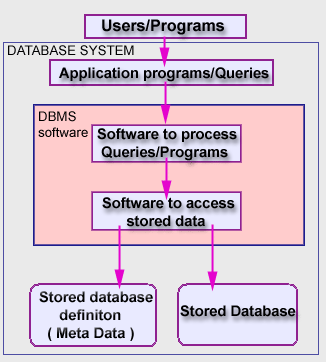Databases play an important role in almost all areas where they are used including business, engineering, medicine, law, education, and library science, to name a few.
A database is a collection of related data, where data means recorded facts. A typical database represents some aspect of the real world and is used for specific purposes by one or more groups of users. Databases are not specific to computers. Examples of non-computerized databases abound: phone book, dictionaries, almanacs, etc. A database has the following implicit properties :
1. A database represents some aspect of the real world.
2. A database is a logically coherent collection of data with some inherent meaning.
3. A databse is designed, built, and populated with data for a specific purpose.
4. A databse can be of any size and of varying complexity.
5. A database may be generated and maintained manually or it may be computerized.
A database management system (DBMS) is a collection of programs that enables users to create and maintain a database. The DBMS is a general-purpose software system that facilitates the process of defining, construction, and manipulating databases for different applications.
Defining a database involves specifying the data types, structures, and constraints for the data to be stored in the database.
Constructing a database is the process of storing the data itself on some storage medium that is controlled by the DBMS.
Manipulating a database includes such functions as querying the database to retrieve specific data, updating the database and generating the reports from the data.

CHARACTERSTICS THAT DISTINGUISH DATABASE APPROACH FROM TRADITIONAL FILE-PROCESSING APPLICATIONS :
- Existence of a catalog : It contains information such as structure of each file, the type and storage format of each data item and various constraints on the data. The information stored in catalog is called meta-data.
- Program data independence : In traditional file processing, the structure of a file is embedded in the access programs, so any changes to the structure of a file may require changing all programs that access this file. By contrast, the structure of data files is stored in DBMS catalog separately from access programs. This property is called program data independence.
- Program operation independence: Users can define operations on data as part of database applications. An operation is specified in two parts - interface of operation : includes operation name and data types of its arguments, implementation of operation : specified separately and can be changed without affecting the interface. This is called
program operation independence.
- Data abstraction : The characteristic that allows program data independence and program operation independence is called data abstraction.
- Support of multiple user views.
- Sharing of data among multiple transactions.
Main Categories of Database users are :
- Administrators.
- Designers.
- End users.
- System analysts and application programmers.
- DBMS system designers and implementers.
- Tool Developers.
- Operators and maintenance personnel.
Advantages of using Databases :
- Potential for enforcing standards.
- Reduced application development time.
- Flexibility.
- Availability of up-to-date information to all users.
- Economies of sale.
Tuesday, August 4, 2009
Introduction to Databases
Posted by
Sunflower
at
8/04/2009 08:21:00 AM
![]()
Labels: Advantages, Data, Databases, File processing systems, introduction, Properties, traditional
|
|
Subscribe to:
Post Comments (Atom)
No comments:
Post a Comment